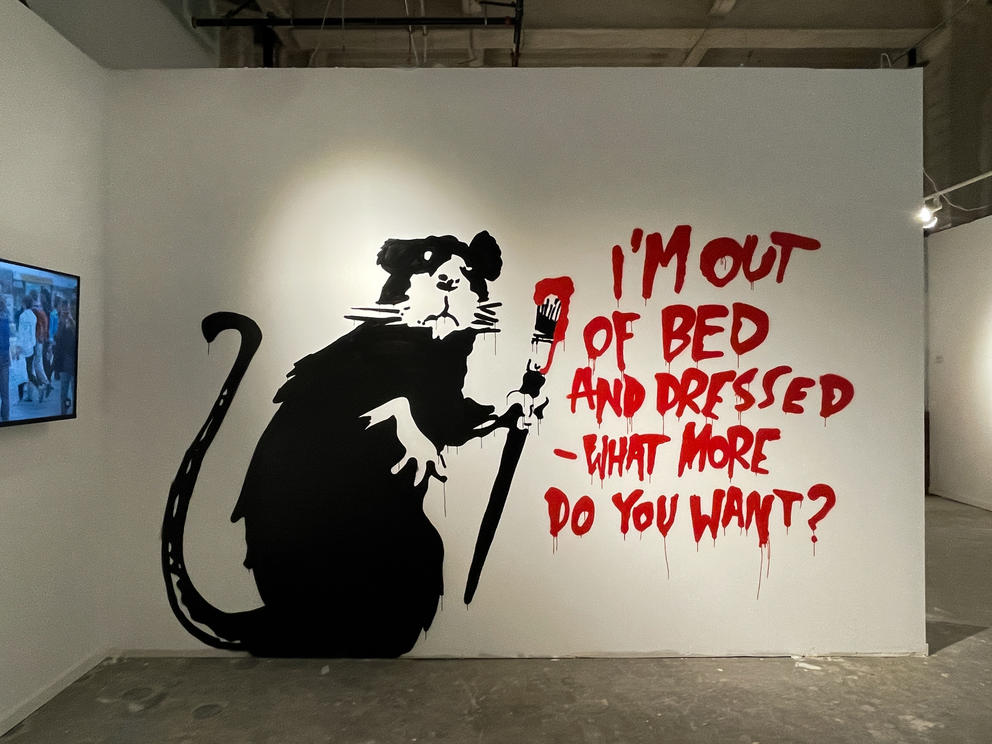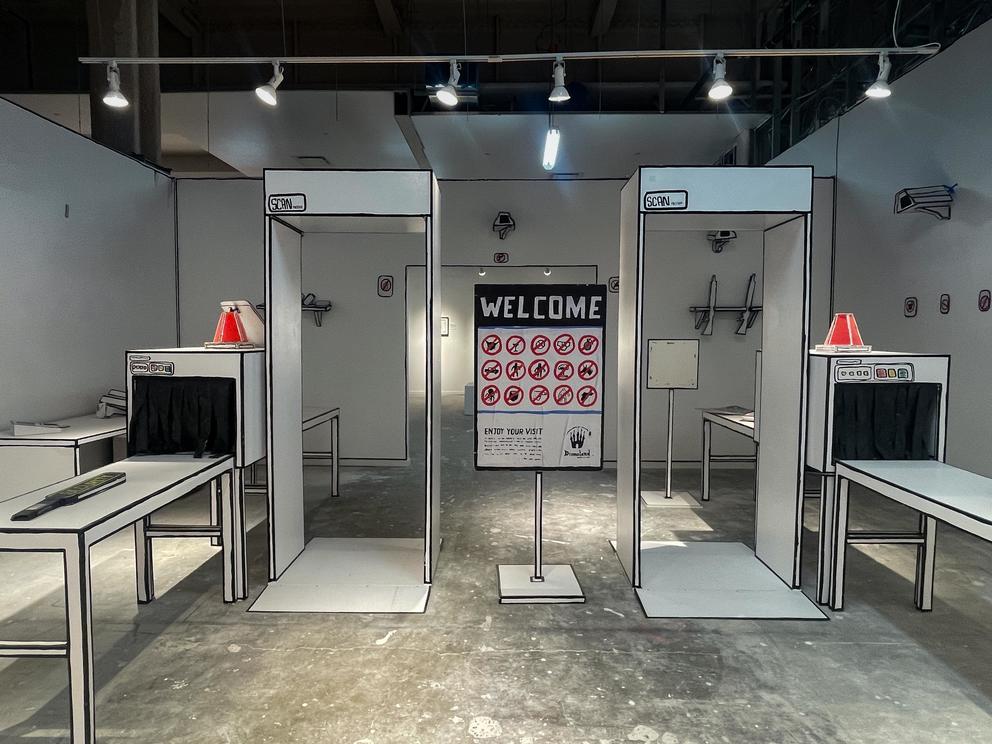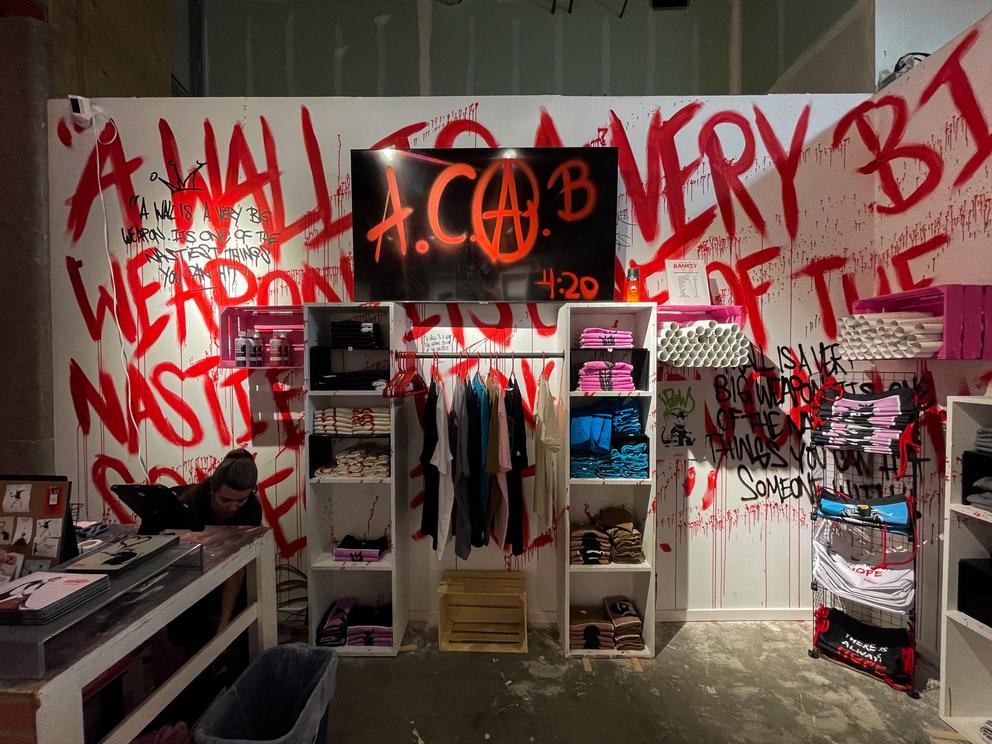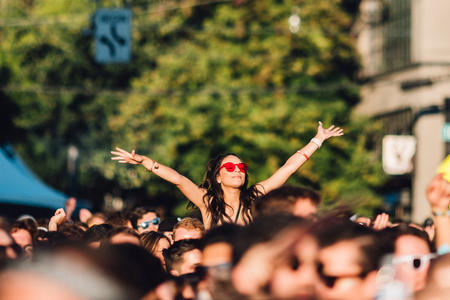This rat is the emblem of the iconic and elusive British street artist Banksy, who for years has used the critters in his work as a sort of signature. Like graffiti artists, rats are nocturnal creatures who scurry through grimy alleys and hide behind trash cans to elude capture.
But ceci n’est pas un Banksy. This wall is a pristine, indoor drywall structure near a ticket counter — not the peeling central London building where Banksy spray-painted the message in 2011. The Seattle painting was made by a team of artists enlisted by Guillermo Quintana, curator of the exhibit The Art Of Banksy: Without Limits (through Sept. 4, Wed-Sun, 10 a.m.-7 p.m., $29.20), which opened July 1 on the first floor of Seattle’s recently revamped Fed branch building. The exhibit comes to Seattle after stints in U.S. cities, including Miami and Atlanta, as well as Europe and Asia.
In this built-for-the-occasion white-walled space, the team has emulated Banksy’s original 2011 mural but, here, the trademark running paint is a deliberate touch rather than a byproduct of quick stealth. In an ironic reversal of Banksy’s original ironic statement, this is not graffiti.
This pick-axed telephone booth is a copy of a 2006 sculpture by Banksy. Also on view during the show are a giant white semi-circle featuring an embossed Disney-castle and a Yayoi Kusama-esque mirrored “infinity room” as a backdrop for a projection of Banksy's works (and selfies). (Margo Vansynghel/Crosscut)
In The Art of Banksy, things are often not as they seem. The “brick walls,” featuring a version of Banksy’s graffiti of a woman line-drying a zebra’s stripes, are not real. (During my first visit, a day before the show opened, a broom leaned against the wall. Only upon a second visit did I confirm it wasn’t part of the installation.) Throughout the space, visitors encounter reproductions of Banksy’s street art pieces that exist in the wild. The kissing policemen. A cameraman uprooting a flower. A monkey on a detonator.
And the luggage-screening scanners and security cameras at the entrance? All made out of cardboard (a copy of an installation at Banksy’s famous immersive artwork, the depressing amusement park Dismaland).
After walking through the cardboard TSA scene, here minus the actors hired to be rude, I saw all of Banksy’s greatest hits, from the flower-throwing anarchist to the Pulp Fiction guys with bananas for guns. But only 33 of the more than hundred works on view are originals — the rest are printouts or stenciled re-creations of his work on walls, paper and canvas. Suspecting this might be the case, I trained my eyes on Banksy’s varied signatures and the wall texts (unclear at best, misleading at worst), but I couldn’t always tell the real Banksy from the copies. I’m not alone: During the show’s Seoul run, some displeased visitors asked for a refund after learning that the majority of the works were reproductions.
At the entrance to "The Art of Banksy," visitors pass through the luggage-screening scanners and security cameras, which are all made out of cardboard. The installation here is a copy of a room at Banksy’s famous immersive artwork, the depressing amusement park Dismaland. (Margo Vansynghel/Crosscut)
The Art of Banksy: Without Limits, is among a spate of Banksy shows that have popped up across the world in recent years, including The Art of Banksy (produced by the company behind Immersive Van Gogh and not to be confused with this exhibit), Banksy: Genius or Vandal and Banksyland.
Like this show, these exhibits proudly proclaim to be “UNAUTHORIZED.” It’s true — Banksy had nothing to do with these shows, nor did he give his blessing — but the wording makes these pop-ups sound more subversive than they are.
Still, these exhibits have gotten under Banksy’s thick skin. In fact, so many have popped up that the artist — who once "provided high-resolution versions of his work on his website and invited the public to download them and produce their own items," as a trademark ruling points out — now has a section on his website dedicated to these shows, under the banner “PRODUCT RECALL — ART OF BANKSY.” On the website of Pest Control, Banksy’s official authentication service and PR firm, a Q&A declares:
I see a new exhibition of Banksy work has just opened, is it authorised?
Nope. Banksy has NOTHING to do with any of the current or recent exhibitions and they are nothing like a genuine Banksy show. They might be crap so please don’t come to us for a refund.
Exhibit founder Kemal Gürkaynak says the point is to democratize Banksy’s art for a wider audience by making it available to people who “may never get to see Banksy’s art in person,” as he wrote in an emailed statement.
Democratizing art is a good thing — and theoretically in the spirit of the artist himself, who has long railed against the art establishment and its institutions. But a $30 entry fee is not really democratic. (“I don’t charge people to see my art unless there’s a fairground wheel,” Banksy has said.)
Though Banksy has undoubtedly made money off of his work, profit is not his motive. In fact, he has often poked fun at the frenzied art market full of profiteers.
Which brings us to the obvious question: Is this an elaborate spoof orchestrated by the artist himself, hiding under layers of irony? (See Dismaland and also Exit Through the Gift Shop, Banksy’s famously confounding metafilm about the art world and street art’s corruption.) Did he create an exhibit full of faux Banksys to take aim at the endless Banksy-light exhibits? That could be, if the show didn’t feel so lifeless.
You could argue that street art doesn’t belong inside, peeled from a wall and excised from its context (and I’d agree, but it can be important to showcase and preserve it in this way nonetheless). The issue is that in this commercialized setting, without a creative risk taker like Banksy at the helm, an exhibit like this inevitably falls flat.
In 2005, during his Crude Oils exhibition (in which he “reimagined” famous oil paintings), Banksy released more than a hundred live rats in the gallery. To the artist, rats are a symbol of the downtrodden and the poor, who, despite efforts to squash them, continue to persist — a revolutionary message in the artist’s typical anti-capitalist vein.
All that is to say: I have a sense that if Banksy were to get access to a former outpost of the Federal Reserve — the country’s most powerful economic institution — he wouldn’t build out a gallery space. He’d go out in the dead of night and stencil some artworks that would say something about inflation, growing wealth inequality or the war in Ukraine. Or maybe he’d let loose a bunch of rats.
Oh, and: if you're looking for more authentic art experiences, check out our big list of Things to Do in July.
Get the latest in local arts and culture
This weekly newsletter brings arts news and cultural events straight to your inbox.









